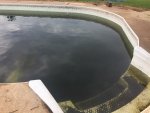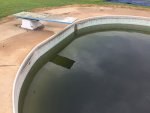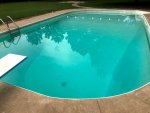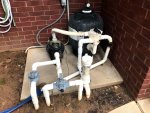Hello, TFP forum!  Before I get to my question, a quick intro:
Before I get to my question, a quick intro:
My family purchased a foreclosure home with an in-ground pool 1.5 years ago, and I spent last summer trying to get the pool up and running. We followed advice from this site given to others who had dealt with foreclosure pools that had turned into ponds, and after pulling out solids (rotten leaves, garbage, dog toys, pool toys, & a tangled mesh cover), followed by several weeks of SLAMing and brushing (and, after over a week of watching dead, suspended algae pass through our filter, eventually also used Chlorox Crazy Clarifier with immediate results), we were eventually, finally rewarded with sparkling, inviting water! I would like to extend a HUGE THANK YOU to the operators of this site, as well as the folks who volunteered their time offering advice to strangers on the internet for all of us to benefit from.



We really had no idea what to expect when we first flipped the power switch, but were pleasantly surprised to find that the pump, filter, and plumbing all seemed to work alright, albeit with plenty of leaks, both in the liner and the plumbing. I've resolved most of those by now, having patched the liner in several places, replaced the Jandy valves, the spider gasket in the multiport valve, and lubing lots of other seals, but still have a small amount of air coming in somewhere. Since the pump strainer basket is broken at the drain plug (missing a piece where the o-ring would ordinarily seal), I went ahead and ordered a replacement 2-speed pump, hoping to save energy and fix the air leak, and bank a spare pump.
Now, the point of this post:

On the intake plumbing, I have a 3-way Jandy valve that clearly switches between the single skimmer and the main drain. Tying into the output of that valve is the output of a 2-way Jandy. My experience last year was that opening that valve would cause the pump to immediately lose its prime, unless I opened it very, very slowly. I also noted that the water level in the pool seemed to be going up, which was very confusing as I had been losing water to liner leaks! I wasn't quite sure where the water was coming from. I thought it might have been seeping into the pool through the liner leaks. I've recently confirmed, though, that opening the valve in question does cause the water level in the pool to go up rather quickly. My best guess is that it's tapping into some kind of well point or cistern. My question for this forum is the following: would the purpose have been to serve as a "free" water source, or a way to deal with ground water problems that might otherwise cause liner float?
There are lots of large liner wrinkles, and the liner is bleached out, stained from mud, and brittle from age. I do plan to replace it after this season, but it would be very nice to know before replacing it if I should be keeping that valve open (and the well point/cistern dry) to keep the liner from floating! The pool is located on about the mid-point of a sloped property, which does accumulate standing water at the bottom. I'd estimate the standing water at the bottom of the property to be close to the level of the deep end of the pool. The shallow end of the pool is where most of the liner wrinkles are, though.
If you've made it this far, thanks for taking the time! I tried my best to be succinct, but it can be a struggle, sometimes!
 Before I get to my question, a quick intro:
Before I get to my question, a quick intro:My family purchased a foreclosure home with an in-ground pool 1.5 years ago, and I spent last summer trying to get the pool up and running. We followed advice from this site given to others who had dealt with foreclosure pools that had turned into ponds, and after pulling out solids (rotten leaves, garbage, dog toys, pool toys, & a tangled mesh cover), followed by several weeks of SLAMing and brushing (and, after over a week of watching dead, suspended algae pass through our filter, eventually also used Chlorox Crazy Clarifier with immediate results), we were eventually, finally rewarded with sparkling, inviting water! I would like to extend a HUGE THANK YOU to the operators of this site, as well as the folks who volunteered their time offering advice to strangers on the internet for all of us to benefit from.



We really had no idea what to expect when we first flipped the power switch, but were pleasantly surprised to find that the pump, filter, and plumbing all seemed to work alright, albeit with plenty of leaks, both in the liner and the plumbing. I've resolved most of those by now, having patched the liner in several places, replaced the Jandy valves, the spider gasket in the multiport valve, and lubing lots of other seals, but still have a small amount of air coming in somewhere. Since the pump strainer basket is broken at the drain plug (missing a piece where the o-ring would ordinarily seal), I went ahead and ordered a replacement 2-speed pump, hoping to save energy and fix the air leak, and bank a spare pump.
Now, the point of this post:

On the intake plumbing, I have a 3-way Jandy valve that clearly switches between the single skimmer and the main drain. Tying into the output of that valve is the output of a 2-way Jandy. My experience last year was that opening that valve would cause the pump to immediately lose its prime, unless I opened it very, very slowly. I also noted that the water level in the pool seemed to be going up, which was very confusing as I had been losing water to liner leaks! I wasn't quite sure where the water was coming from. I thought it might have been seeping into the pool through the liner leaks. I've recently confirmed, though, that opening the valve in question does cause the water level in the pool to go up rather quickly. My best guess is that it's tapping into some kind of well point or cistern. My question for this forum is the following: would the purpose have been to serve as a "free" water source, or a way to deal with ground water problems that might otherwise cause liner float?
There are lots of large liner wrinkles, and the liner is bleached out, stained from mud, and brittle from age. I do plan to replace it after this season, but it would be very nice to know before replacing it if I should be keeping that valve open (and the well point/cistern dry) to keep the liner from floating! The pool is located on about the mid-point of a sloped property, which does accumulate standing water at the bottom. I'd estimate the standing water at the bottom of the property to be close to the level of the deep end of the pool. The shallow end of the pool is where most of the liner wrinkles are, though.
If you've made it this far, thanks for taking the time! I tried my best to be succinct, but it can be a struggle, sometimes!
Last edited:

